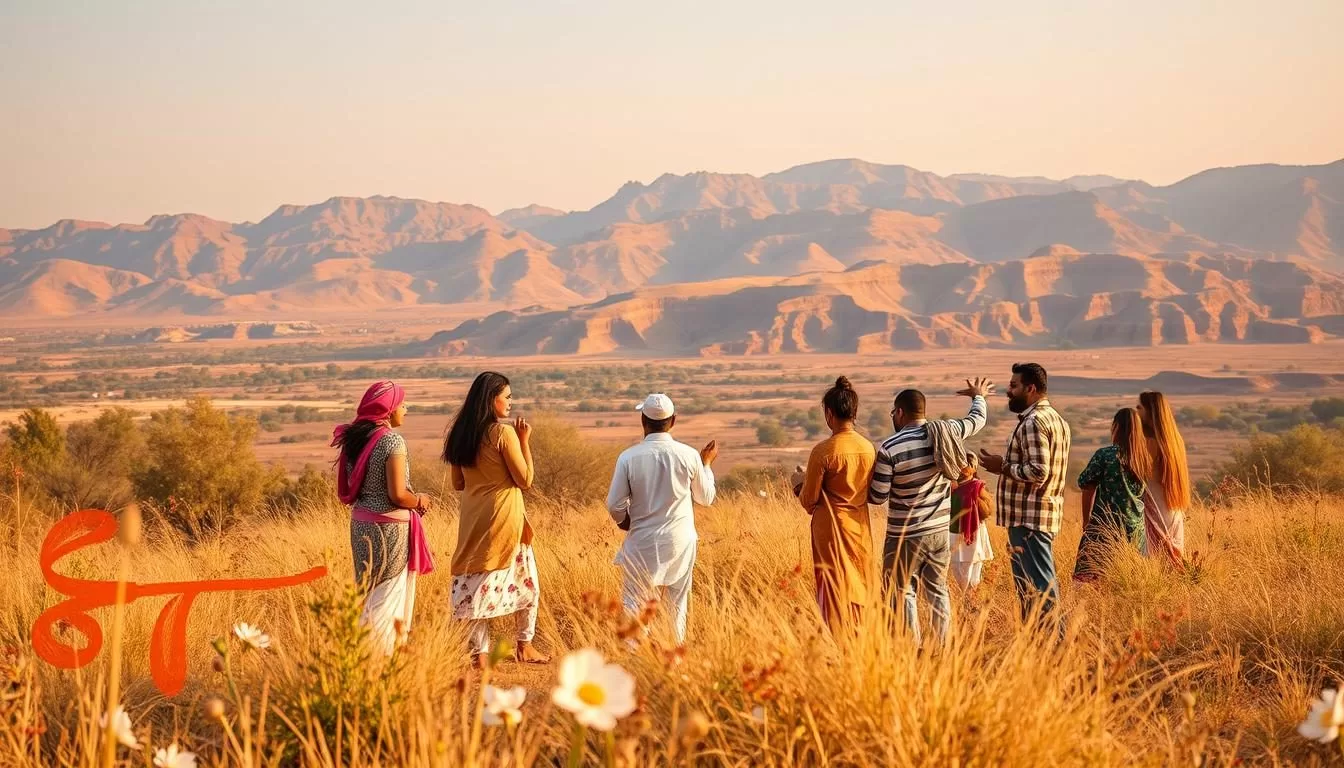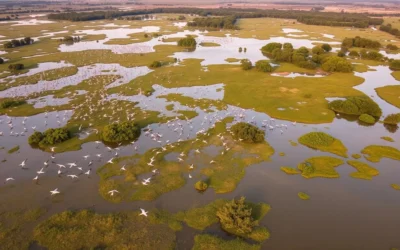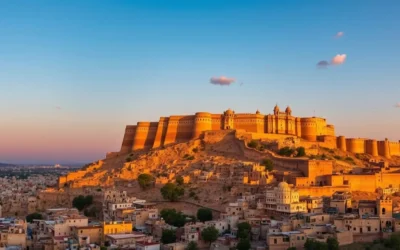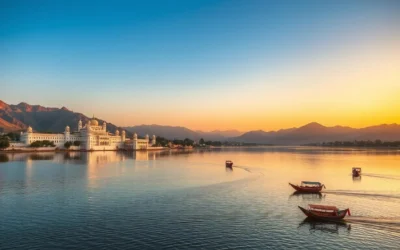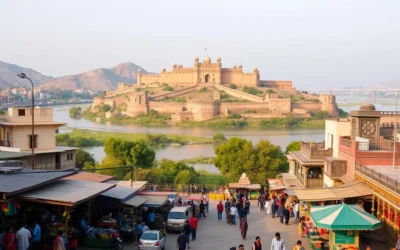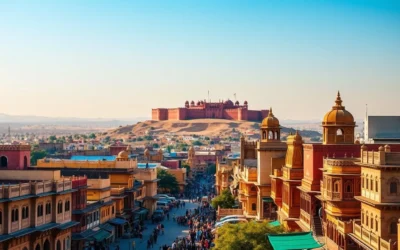✓ Accommodations✓ Flights✓ Rental Cars
As you explore the culturally rich state of Rajasthan, you’ll discover a complex linguistic landscape. With 22 distinct official languages in India, Rajasthan’s linguistic diversity is a reflection of the country’s broader cultural heritage.
The region is predominantly home to Rajasthani languages, a group of Western Indo-Aryan languages that have evolved from Sanskrit. These languages are not only a means of communication but also a carrier of the region’s rich cultural identity.
Understanding the mother tongues and linguistic diversity of Rajasthan will enhance your appreciation of the state’s complex history and cultural development. This guide will navigate you through the sometimes confusing terminology around Rajasthani languages and dialects, clarifying their relationships and distinctive features.
The Linguistic Landscape of Rajasthan
As you explore Rajasthan, you’ll discover a rich tapestry of languages that reflect the state’s diverse geography and cultural heritage. The state’s linguistic diversity is influenced by its varied geography, ranging from the arid Thar Desert to the eastern plains.
Geographical Distribution of Languages
The geographical features of Rajasthan have significantly impacted the distribution of languages across its regions. Different languages and dialects are predominantly spoken in various areas, creating distinct linguistic boundaries within the state. For instance, Rajasthani languages are not only spoken in Rajasthan but also in neighboring states like Gujarat, Madhya Pradesh, and Haryana. The overlap of language regions is particularly notable in border districts, where Rajasthan meets these neighboring states.

Language Demographics in Rajasthan
The demographic breakdown of language speakers in Rajasthan reveals a complex picture of linguistic dominance and minority languages. Historical migration patterns have shaped the current distribution of language speakers across different districts. Urban centers like Jaipur, Jodhpur, and Udaipur have emerged as multilingual hubs, contrasting with more linguistically homogeneous rural areas. The correlation between language demographics and other social factors like education, economic development, and cultural identity varies across different regions of the state.
Understanding the language demographics in Rajasthan provides insights into the social fabric of the state. With over 25 million people speaking Rajasthani languages, the linguistic landscape is diverse and vibrant. The prevalence of Standard Rajasthani or Standard Marwari as a lingua franca among the Rajasthani people highlights the importance of language in shaping regional identity.
Rajasthan, India: Official and Widely Spoken Languages
The official and widely spoken languages in Rajasthan play a significant role in shaping the state’s communication landscape. You will discover how different languages serve various purposes, from government and education to cultural expression and everyday interactions.
Hindi: The Official Language
Hindi is one of the official languages of India and is widely spoken across the country, including Rajasthan. As the primary language for government, education, and formal communication, Hindi plays a crucial role in the state’s administrative functions. It is used in government offices, educational institutions, and official documents, making it an essential language for the people of Rajasthan to know.
You will find that Hindi is also the language used in most formal settings, such as official events and ceremonies. Its widespread use facilitates communication among people from different regions of the state and country.
Rajasthani: The Regional Identity
Rajasthani is a language that holds significant cultural and regional importance in Rajasthan. It serves as a marker of regional identity and cultural heritage, reflecting the history and traditions of the people. Despite not being officially recognized at the national level, Rajasthani is widely spoken and cherished by the locals.
In 2003, the Rajasthan Legislative Assembly passed a resolution seeking recognition for Rajasthani in the Eighth Schedule of the Constitution of India. Furthermore, in March 2023, the state government formed a committee to consider making Rajasthani an official language, highlighting the ongoing efforts to preserve and promote this important aspect of Rajasthani culture.

English and Other Administrative Languages
English continues to play a significant role in administration, higher education, and the tourism industry, particularly in urban areas and tourist destinations. It is widely used in official contexts, such as government offices and educational institutions, facilitating communication with international visitors and businesses.
Other languages may also be used in specific administrative contexts or among certain populations, contributing to the linguistic diversity of Rajasthan. Understanding the roles of these languages helps you appreciate the complex linguistic landscape of the state.
The Rajasthani Language Group
As you explore the linguistic diversity of Rajasthan, you’ll discover the rich tapestry of the Rajasthani language group, which is part of the Western Indo-Aryan language family.
The Rajasthani languages are often conflated with Hindi in the Indian national census, but they form a distinct sub-branch of the Western Indo-Aryan languages. References to a separate Rajasthani language date back to the 8th century, but a distinct Rajasthani linguistic identity emerged much later, in the 18th century.
Classification and Origins
The Rajasthani language has its roots in Sanskrit and evolved through various Prakrit stages. This historical evolution has contributed to its unique characteristics. The classification of Rajasthani as a distinct language or a dialect cluster within the Hindi language family is a matter of scholarly debate.
Geographical isolation and the region’s unique history have played significant roles in shaping the Rajasthani language. It serves as an important cultural identifier for the community, connecting people to their heritage and traditions.
Major Dialects and Their Distribution
The Rajasthani language group comprises several major dialects, each with its own geographical distribution across Rajasthan. Historical kingdoms and principalities in the region have influenced the development of distinct dialects, often corresponding to former royal states.
You’ll find that the Rajasthani dialects are not only linguistically significant but also culturally important, reflecting the diversity and richness of the region’s history.
Understanding these dialects and their distribution provides insights into the complex linguistic landscape of Rajasthan and the community that speaks them.
Marwari: The Dominant Rajasthani Dialect
In the vast expanse of Rajasthan, Marwari emerges as a dominant dialect, rich in history and cultural significance. As you delve into the world of Rajasthani languages, you’ll find that Marwari serves as a lingua franca across many parts of western Rajasthan.
History and Development
Marwari has its roots in the Marwar region, from where it originated and gained prominence. The historical development of Marwari is closely tied to the trade networks and the influence of the Marwari merchant community. Over time, Marwari evolved, absorbing elements from various languages it came into contact with, thus enriching its vocabulary and grammatical structure.
Speakers and Geographic Spread
Marwari is primarily spoken by the Marwari community not only in Rajasthan but also in Gujarat and some areas of Pakistan. According to the 2001 Census, there are approximately 7,936,183 speakers of Marwari in India, with 6,279,105 residing in various districts of Rajasthan, including Jodhpur, Bikaner, Barmer, Nagaur, and Pali. This widespread distribution underscores Marwari’s importance as a major dialect within the Rajasthani language family.
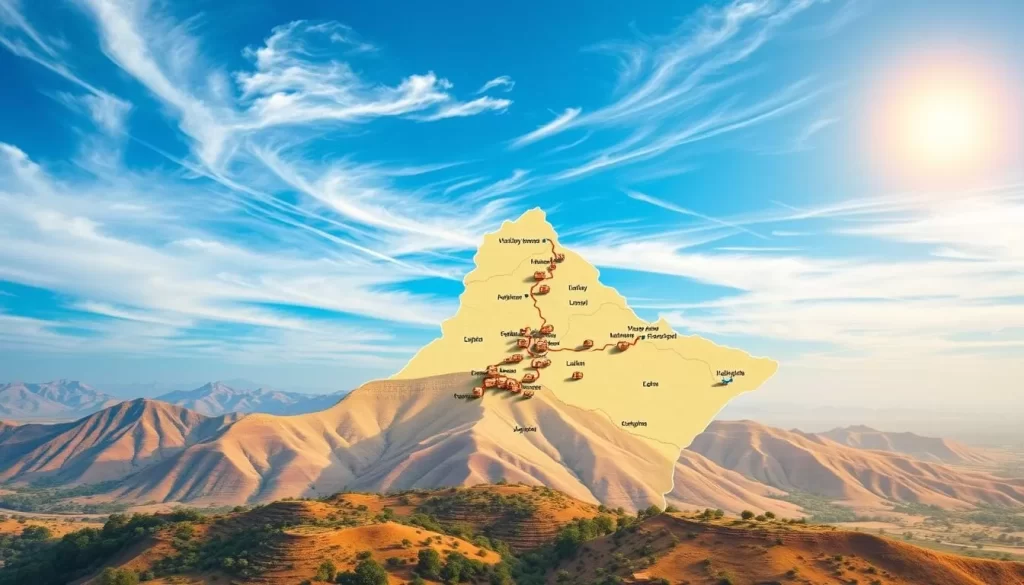
Distinctive Features of Marwari
Marwari boasts several distinctive phonological features, including unique vowel sounds and consonant patterns that differentiate it from standard Hindi and other Rajasthani dialects. The language also exhibits grammatical peculiarities and vocabulary differences that contribute to its distinctive character. Furthermore, Marwari has been influenced by, and has influenced, neighboring languages, thereby creating a rich linguistic tapestry in the region.
As you explore Marwari further, you’ll notice its rich literature and the fact that it is taught from primary to post-graduate levels, highlighting its significance in the educational curriculum. The language’s ability to adapt and evolve while maintaining its traditional roots is a testament to its vitality and the cultural identity it represents.
Other Significant Rajasthani Dialects
Beyond Marwari, Rajasthan is home to several other significant Rajasthani dialects, each with its unique characteristics and cultural importance. You will explore some of these dialects and their distinct features in this section.
Mewari
Mewari is spoken by approximately 4,212,000 people in the Mewar region of Rajasthan and Madhya Pradesh. It is centered around Udaipur and reflects the cultural heritage of this historic area. Mewari has distinctive phonological and lexical features that differentiate it from other Rajasthani dialects.
Dhundhari
Dhundhari is spoken by about 1,476,000 people in the Dhundhar region of northeastern Rajasthan, including Jaipur, Sawai Madhopur, Dausa, Tonk, and parts of Sikar and Karauli district. As the dialect of Rajasthan’s capital area, Dhundhari plays a significant role in the state’s cultural production.
Harauti
Harauti, also known as Hadauti, is spoken by around 2,944,000 people in the Hadoti region of southeastern Rajasthan, covering Kota and Bundi districts. It has unique linguistic characteristics and cultural associations that are important to the local identity.
Bagri
Bagri is spoken by approximately 1,657,000 people across the Bagar region, which spans parts of Rajasthan, Haryana, and Punjab. It is considered a transitional dialect between Rajasthani and Punjabi, reflecting the cultural and linguistic diversity of the areas where it is spoken.
These dialects not only reflect the geographical diversity of Rajasthan but also serve as important markers of local identity within the broader Rajasthani cultural sphere. Understanding these dialects provides insights into the rich linguistic heritage of the region and its people.
You can see the distribution of these dialects across different districts and parts of Rajasthan, highlighting the state’s linguistic diversity.

Linguistic Characteristics of Rajasthani Languages
As you explore the Rajasthani language, you’ll discover its unique linguistic characteristics that set it apart from other Indo-Aryan languages. The Rajasthani language is a treasure trove of linguistic features, shaped by its rich history and cultural context.
Phonology and Pronunciation
Rajasthani languages boast a rich phonological system, with 11 vowels and 38 consonants. One of the distinctive features of Rajasthani is the preservation of retroflex consonants from Vedic Sanskrit, such as ṭ (ट), ṭh (ठ), ḍ (ड), ḍh (ढ), and ṇ (ण). The consonant ḷ (ळ) is also frequently used. Some dialects, like Bagri, have developed tonal features, with three lexical tones: low, mid, and high.
Grammar and Syntax
Rajasthani languages exhibit a complex grammatical structure. They have two numbers and two genders, with three cases. The language belongs to a group that mixes three types of case marking systems: nominative-accusative, absolutive-ergative, and tripartite. The basic sentence typology is subject-object-verb, similar to most other Indo-Iranian languages.
Vocabulary and Influences
The vocabulary of Rajasthani languages is a reflection of their history and cultural exchange. It includes words of pure Sanskritic origin (tatsam), evolved Sanskrit words (tadbhav), and loanwords from Persian, Arabic, and other languages. The script tradition has also evolved, with Devanagari being the primary script used today, although other scripts like Mahajani were historically used for commercial purposes.
You can see that the Rajasthani language is not just a means of communication but also a carrier of tradition and cultural heritage. Understanding its linguistic characteristics provides valuable insights into the history and identity of its speakers.
Conclusion: The Future of Rajasthan’s Linguistic Heritage
Rajasthan’s linguistic diversity is a valuable asset that requires careful preservation and promotion. As you’ve seen, the Rajasthani language is spoken by over 25 million people across different parts of the region.
The government’s inclusion of Rajasthani in the state’s open school system in 2019 marks a significant step towards its preservation. This move, coupled with the language being taught from primary to post-graduate level, underscores the importance of education in maintaining linguistic heritage.
Efforts to document and revitalize Rajasthani languages through technology, such as digital dictionaries and social media groups, are also crucial. As you consider the future of Rajasthan’s linguistic landscape, it’s clear that a combination of community-led initiatives, government support, and educational programs will be vital.
By recognizing and celebrating the multilingual reality of Rajasthan, we can ensure the continued vitality of its languages and the rich cultural tradition they represent.
The above is subject to change.
Check back often to TRAVEL.COM for the latest travel tips and deals.
